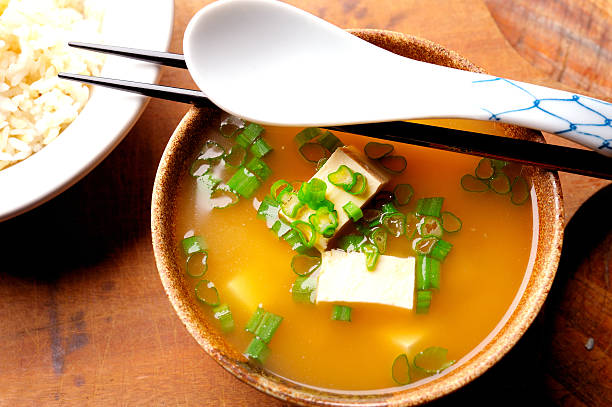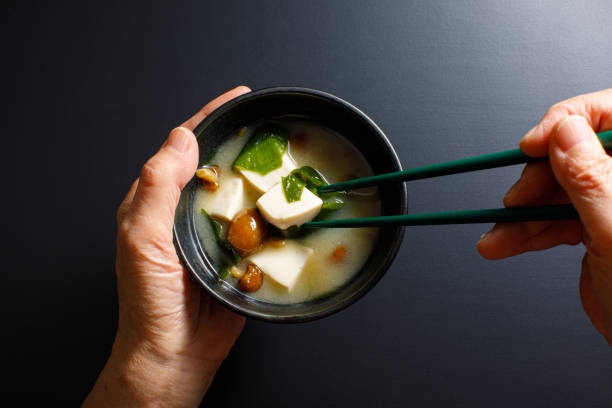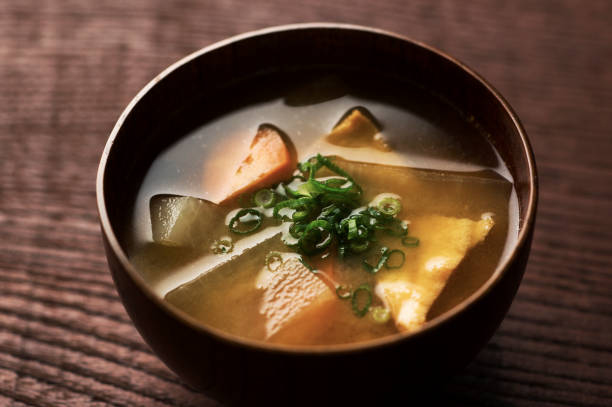Miso soup is a traditional Japanese dish that has become popular around the world for its flavorful, comforting taste and numerous health benefits. But if you’re trying to watch your calorie intake, you may be wondering just how many calories are in a bowl of miso soup. The answer depends on a few factors, including the type of miso paste used, the ingredients added to the soup, and the serving size. In this article, we’ll take a closer look at the calorie content of miso soup and provide some tips for controlling your intake of this tasty treat.
To start, let’s define miso soup. This dish is made by mixing miso paste, a fermented soybean paste, with dashi, a Japanese fish broth. The mixture is then simmered and other ingredients, such as tofu, vegetables, and seaweed, may be added. The resulting soup is savory, slightly sweet, and slightly salty, with a rich, umami flavor.
Now, onto the question at hand: how many calories are in a bowl of miso soup? The answer is not straightforward, as the calorie content of miso soup can vary widely depending on the ingredients used. However, we can make some generalizations based on the calorie content of the main ingredients.
One serving of miso paste, which is about 2 tablespoons, contains around 50-70 calories. Dashi, on the other hand, is relatively low in calories, with a cup containing only about 10-20 calories. Tofu, a common ingredient in miso soup, is also low in calories, with a half-cup serving containing around 40-60 calories. Vegetables, such as carrots, onions, and greens, are very low in calories, with a cup containing only around 25-50 calories.
So, if we consider a typical serving of miso soup to be one cup, and assume that the soup contains 2 tablespoons of miso paste, a cup of dashi, and a half-cup of tofu, the calorie content would be around 130-170 calories. This is a rough estimate, as the exact calorie content will depend on the specific ingredients used and their proportions.
It’s worth noting that some variations of miso soup can be higher in calories. For example, if the soup contains additional protein sources, such as chicken or beef, the calorie content will be higher. Additionally, if the soup is made with a more caloric miso paste, such as red miso, which is made from a mixture of soybeans, barley, and rice, the calorie content will be higher than if a lighter-colored miso paste, such as white or yellow miso, is used.
So, how can you control your intake of calories in miso soup? Here are a few tips:
Use a lighter-colored miso paste, such as white or yellow miso, which tends to be lower in calories than red miso.
Limit the amount of miso paste used in the soup. While miso paste adds flavor and depth to the soup, it is also relatively high in calories. Using less miso paste will result in a lower calorie soup.
Choose low-calorie protein sources, such as tofu or seafood, rather than higher calorie options like beef or chicken.
Add plenty of low-calorie vegetables, such as greens, carrots, and onions, to the soup. This will help to bulk up the soup and add flavor and nutrients, while keeping the calorie content low.
It is important to note that the caloric content of miso soup can vary based on the specific ingredients used and the recipe followed. For example, using a broth other than dashi, such as chicken or beef broth, will change the caloric content of the soup. Additionally, adding ingredients such as tofu, seaweed, or other vegetables will also affect the overall caloric content of the soup.
Despite its relatively low caloric content, miso soup can still be a significant source of sodium. One cup of miso soup contains 879 milligrams of sodium, which is about 37% of the recommended daily value for sodium. High levels of sodium intake have been linked to a variety of health problems, including high blood pressure, heart disease, and stroke. Therefore, it is important to be mindful of your sodium intake when consuming miso soup, especially if you are on a low-sodium diet or have high blood pressure.
However, miso soup also has several potential health benefits. Miso paste, which is made from fermented soybeans, is a good source of protein, fiber, and vitamins and minerals, including B vitamins, zinc, and copper. Additionally, the fermentation process used to make miso paste has been linked to a variety of potential health benefits, including improving digestion, boosting the immune system, and reducing the risk of certain types of cancer.
Despite these potential benefits, it is important to consume miso soup in moderation as part of a balanced diet. While miso soup is generally considered to be a healthy food, it is not a substitute for a varied and nutritious diet that includes a variety of fruits, vegetables, whole grains, and lean proteins.
In conclusion, miso soup is a low-calorie, traditional Japanese soup that is generally considered to be a healthy food. However, it is important to be mindful of the sodium content of miso soup, as high levels of sodium intake can have negative health effects. Miso soup also has several potential health benefits, thanks to the nutrients and fermentation process involved in making miso paste. To ensure a healthy diet, it is important to consume miso soup in moderation as part of a varied and nutritious diet.

 Home
Home Health
Health Diet & Nutrition
Diet & Nutrition Living Well
Living Well More
More













